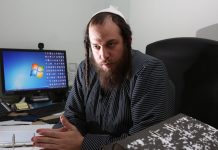From a dormant Jewish community 35 years ago, Pico-Robertson has expanded —like dripping water, one storefront after another—into the flourishing Jewish neighborhood evident today. With top-tier rabbanim, a panoply of Torah flavors, a family-oriented suburban feel, year-round sunny weather, a burgeoning restaurant scene, and a young, eclectic vibe, Pico-Robertson is a Diaspora community that its residents insist is second to none.
In a 20-minute stroll down Pico—the “kosher corridor” from Roxbury to Crescent Heights—I encounter 30 shuls, kollelim and outreach programs—Persian, Modern Orthodox, kiruv, yeshivish, Chabad, Carlebach, Yemenite, chasidic, Israeli. There are boutique shuls for musicians and artists, one for Moroccans, another for French-Moroccans. And there are more than 30 kosher restaurants (see sidebar).
With such staggering variety in close proximity, it calls to mind the Gemara that states, “Shraga b’tihara, mai ahanei, a candle in bright daylight seems superfluous” (Chulin 60b).
“In this case, variety is perfect for the ‘age of customization,’” Rabbi Markman says, waving toward Pico Boulevard and drinking it all in. “It’s like a garment district or diamond district. Every new shul and restaurant solidifies Pico-Robertson as a world-class Torah destination.”
Pre-Boom Times
Things weren’t always this way. Over the decades, various forces conspired to turn Pico-Robertson into a Torah boomtown…a vibrant Modern Orthodox community, the activities of Chabad, the massive influx of Persian Jewish immigrants, and—the focus of this article—the baal teshuvah movement.
If Pico-Robertson could talk, it would take us back to the 1950s and ’60s, when Torah life was largely invisible in this neighborhood of modest single-family homes. “Pico-Robertson was very Jewish, but you rarely saw anyone walking on Shabbos,” says Alan Rich, who grew up in Pico during this era dominated by “Conservative synagogues so large they had two bar mitzvahs every Shabbos.” Then, with the 1970s migration to suburbia, the area east of Robertson underwent ethnic change, while the area to its west remained “culturally Jewish.”
A 1980 snapshot of Pico-Robertson shows a small Chabad and the esteemed Rabbi Sholom Tendler at a fledging high school founded by Rabbi Marvin Hier. Beyond this, Yiddishkeit languished. At B’nai David-Judea, Rabbi Phillip Shroit, a loyal talmid of Rav Moshe Feinstein, zt”l, was struggling to install a mechitzah. Rabbi Allan Summers had passed away, leaving Anshe Emes alive only because of the rebbetzin’s determination. One oasis, for those willing to walk to Beverly Hills, was Beth Jacob, the largest Orthodox shul west of the Mississippi.
Many saw the Jewish future of this neighborhood as grim. Rabbi Yitzchok Summers, who later revitalized his father’s shul, recalls one local rabbi saying at the time, “Our job is to hold the reins of the cart as it hurtles downhill.”
Baal Teshuvah Revolution
If Pico-Robertson could talk, it would tell us about Dick Horowitz. A high-powered life-insurance salesman and, at that time, a Conservative Jew, Horowitz read the 1975 Harvard Jewish Population Study predicting that American Jewry would nearly disappear due to intermarriage.
“I’m a numbers person, and I saw everything except Orthodoxy rapidly heading toward zero,” Horowitz tells Ami from his office in Beverly Hills, where kiruv materials adorn the reception area. “As someone who wanted proud Jewish children and grandchildren, Orthodoxy was the obvious answer.” (His demographic research later produced the famous chart called “Will Your Grandchildren Be Jewish?” which appeared in The New York Times and caught the attention of Bibi Netanyahu.)
In the late ’70s, Dick and his wife, Beverly, decided to enroll their two sons in an Orthodox day school, an intuitive move confirmed by a Conservative rabbi who told them, “Conservative day school will teach your children what being Jewish is about. Orthodox day school will teach your children to be Jewish.”
Providentially, one of Dick’s employees was a single mother who raved about Hillel Hebrew Academy in Beverly Hills, whose principal, Rabbi Menachem Gottesman, had kindly given her a tuition break. The Horowitzes connected with Rabbi and Rebbetzin Gottesman, whose warm welcome set them on a spectacular Orthodox journey that reverberates in the annals of Los Angeles Jewry.





















